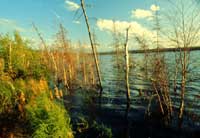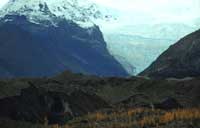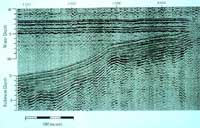|
Paleohydrology Across Central Alaska: A Multiproxy Approach to Lake-Level Records - Collaborators include Bruce Finney, Mary Edwards, Lesleigh Anderson among others
The primary objective of this project is to produce new multi-proxy paleoclimate records from Central Alaska to test hypotheses concerning the cause of shifts in the precipitation-evaporation balance from 18 ka to present. Previous work suggests (1) a prolonged period of aridity from the Last Glacial Maximum to the glacial to interglacial transition, (2) a two-stage increase in the moisture balance roughly correlative with the two-step rise in sea level, and (3) a complicated history of water balance shifts during the Holocene, indicated by multiple transgression-regression sequences in Dune Lake. This research project has two key goals (1) expand the network of sites with decadal to century-scale lake-level data to identify the spatial and temporal pattern of changes in the precipitation-evaporation balance from ~18 ka to present and (2) identify fluctuations in the moisture balance for the past 2000 year at annual to decadal-scale from several lakes. These records are needed to understand the long-term atmospheric dynamics of the Arctic and to assess the significance of shifts in the precipitation-evaporation balance. The ultimate goal is to reconstruct the Holocene climate history of the region with a series of studies analyzing the sedimentology, geochemistry, magnetic properties, pollen content, stable isotope composition, and biomarker compounds.
.

Resulting Publications include
Lake-Level Reconstructions and Paleohydrology of Birch Lake, Central Alaska, Based on Seismic Reflection Profiles and Core Transects. Lake-level history for Birch Lake, Alaska, was reconstructed using seismic profiles and multiproxy sedimentary analyses including sedimentology, geochemistry, magnetic susceptibility, and palynology. Twenty-two seismic profiles (18 km total) and eight sediment cores taken from the lake margin to its depocenter at 13.5 m provide evidence for low lake stands during the late Pleistocene and Holocene. Thirty-one AMS radiocarbon dates of macrofossils and pollen provide a century-scale chronology. Prior to 12,700 14C yr B.P., the lake, which now over- flows, was either seasonally dry or desiccated for prolonged periods, indicating a severe period of aridity. Lake level rose more than 18 m between 12,700 and 12,200 14C yr B.P. before falling to 17 m below the level of overflow. Between 11,600 and 10,600 14C yr B.P. the water remained between 14 and 17 m below the overflow level. Onlap sedimentary sequences were formed during a transgression phase between 10,600 and 10,000 14C yr B.P. Between 10,000 and about 8800 14C yr B.P. the lake was between 6 and 9 m below the overflow level. Lake level again rose, approaching the overflow level, between 8800 and 8000 14C yr B.P. Seismic and core evidence of minor erosional events suggest lowstands of 2-6 m until 4800 14C yr B.P. There have been no prolonged periods of lake-level depression since that time. The major restructuring of the climate system during deglaciation evidently generated a complex set of fluctuations in effective moisture in interior Alaska, which likely affected eolian processes and vegetation development, as well as lake levels.
Holocene Climate Inferred from Oxygen Isotope Ratios in Lake Sediments, Central Brooks Range, Alaska. Analyses of sediment cores from two lakes in the central Brooks Range provide temperature and moisture balance information for the past _8500 cal yr at century-scale resolution. Two methods of oxygen isotope analysis are used to reconstruct past changes in the effective moisture (precipitation minus evaporation) and temperature. Effective moisture is inferred from oxygen isotope ratios in sediment cellulose from Meli Lake (area _0.13 km2, depth 19.4 m). The lake has a low watershed-to-lake-area ratio (7) and significant evaporation relative to input. Summer temperature shifts are based on oxygen isotope analyses of endogenic calcite from Tangled Up Lake (area _0.25 km2, depth 3.5 m). This basin has a larger watershed-to-lake-area ratio (91) and less evaporation relative to input. Sediment oxygen isotope analyses from the two sites indicate generally more arid conditions than present prior to _6000 cal yr B.P. Subsequently, the region became increasingly wet. Temperature variability is recorded minimally at centennial scale resolution with values that are generally cool for the past _6700 cal yr. The timing and direction of climate variability indicated by the oxygen isotope time series from Meli and Tangled Up lakes are consistent with pre- viously established late Holocene glacier advances at _5000 cal yr B.P. in the central Brooks Range, and high lake-levels at Birch Lake since _5500 cal yr B.P. This unique use of oxygen isotopes reveals both moisture balance and temperature histories at previously un- detected high-resolution temporal scales for northern Alaska during the middle to late Holocene.
A 31,000 Year Record of Paleoenvironmental and Lake-Level Change from Harding Lake, Alaska, USA. Physical and geochemical proxy analyses of sediment cores from Harding Lake in central Alaska are used to reconstruct paleoenvironmental change and millennial scale fluctuations in lake level for the last w31,000 years. We analyzed a composite 422 cm core from the lake depocenter (42.1 m water depth) and identified 4 distinct lithologic units based on variability in dry bulk density, organic matter, biogenic silica, carbon to nitrogen mass ratios (C/N), organic matter carbon isotopes (d13C), pollen, and elemental abundances via scanning X-ray fluorescence, with age control provided by 16 Accelerator Mass Spectrometry radiocarbon dates and 210Pb dating. In addition, we analyzed a transect of cores from 7.1 m, 10.75 m, 15.91 m, and 38.05 m water depths to identify lake level fluctuations and to characterize sediment compositional changes as a function of water depth. Organic matter content and magnetic susceptibility values in surface sediments from all transect cores show a strong correlation with water depth. Interpretation of four lithologic units with well-dated contacts produced a record of water-depth variations that is consistent with independent climate records from eastern Beringia. Basal coarse- grained sediments (quartz pebble diamicton) were deposited prior to 30,700 calendar years before present (yr BP), possibly from fluvial reworking or deflation during a period of severe aridity. Unit 1 sediments were deposited between 30,700 and 15,700 yr BP and are characterized by a low organic matter content, a high magnetic susceptibility, and low biogenic silica concentrations resulting from very low lake levels, low terrestrial and in-lake productivity and a high flux of clastic sediment. An abrupt increase in organic matter and biogenic silica concentration marks the transition into Unit 2 sediments, which were deposited between 15,700 and 9,400 yr BP when lake levels were higher and variable (relative to Unit 1). The transition to full interglacial conditions at 9,400 yr BP marks the beginning of Unit 3. Here an abrupt increase in the sedimentation rate, organic matter and biogenic silica concentration occurs (along with a corresponding decrease to low magnetic susceptibility). These high values persist until 8,700 yr BP, signifying a rapid rise to higher lake levels (in comparison to Units 1 and 2). Unit 4 sediments were deposited between 8,700 yr BP to 2010 AD and generally contain high concentrations of organic matter and biogenic silica with low magnetic susceptibility, suggesting that lake levels were relatively high and stable during the middle to late Holocene.
A 40,000-yr Record of Environmental Change from Burial Lake in Northwest Alaska. Burial Lake in northwest Alaska records changes in water level and regional vegetation since _39,000 cal yr BP based on terrestrial macrofossil AMS radiocarbon dates. A sedimentary unconformity is dated between 34,800 and 23,200 cal yr BP. During all or some of this period there was a hiatus in deposition indicating a major drop in lake level and deflation of lacustrine sediments. MIS 3 vegetation was herb-shrub tundra; more xeric graminoid-herb tundra developed after 23,200 cal yr BP. The tundra gradually became more mesic after 17,000 cal yr BP. Expansions of Salix then Betula, at 15,000 and 14,000 cal yr BP, respectively, are coincident with a major rise in lake level marked by increasing fine-grained sediment and higher organic matter content. Several sites in the region display disrupted sedimentation and probable hiatuses during the last glacial maximum (LGM); together regional data indicate an arid interval prior to and during the LGM and continued low moisture levels until _15,000 cal yr BP. AMS 14C dates from Burial Lake are approximately synchronous with AMS 14C dates reported for the Betula expansion at nearby sites and sites across northern Alaska, but 1000-2000 yr younger than bulk-sediment dates.
|




